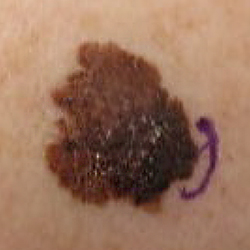
Unlike cancers that develop inside the body, skin cancer forms on the surface of our skin making early detection possible.
“Without question, early detection has the potential to save lives,” says Dr. Richard Arenas, Chief of Baystate's Division of Surgical Oncology. “When caught and treated early, skin cancers are highly curable. Fortunately for us all, detection doesn’t require a medical degree or any special equipment. All you have to do is to know what to look for and to perform self-examinations regularly.
Signs of skin cancer: what to look for
There are many forms of skin cancer and the early signs of each can vary in size, shape, and appearance. Arenas advises patients to perform self-examinations on a monthly basis in a well-lit space. “The bathroom is ideal as the mirror will allow you to look at your back and other difficult to see areas.”
He recommends keeping the A, B, C, D, and Es of skin cancer (see photos below) in mind:
- Asymmetry: one half doesn’t match the other
- Border irregularity: a growth with borders that are ragged, scalloped, blurred, or poorly defined
- Color variation: color that is not consistent throughout the growth. This may include the appear of different colors (i.e. black and red) or a single color that appears darker and lighter in different parts of the growth.
- Diameter: any growth that wider than 6 mm (roughly the size of a pencil eraser)
- Evolution: any growth that change in size, shape or color
In addition to the A, B, C, D, and Es, Arenas encourages patients to keep an eye out for sores that don’t heal, red or brown patches of skin that are rough or scaly, any bumps that bleed easily, any new growths or spots, and any mole that stands out as significantly different from nearby moles (size, shape, or color) or appears without any other moles nearby.
“If something looks off, make an appointment to see your doctor or dermatologist,” he says. “The best-worst case scenario is they’ll say it’s nothing to worry about. The best-best case scenario is you’ll spot a problem early when it’s highly treatable.”
Should I Use a Skin Cancer Detection App?
Today, it’s no surprise that there are a number of smartphone apps designed to help you track any changes to your skin. Arenas says, “Anything that reminds you to look for signs of skin cancer is a good thing. That said, the technology is not perfect and I would not rely solely on an app for a definitive diagnosis. If you see anything suspicious, your best course of action is to get an appointment with a doctor. Never let an app discourage from making an appointment. Simply put, early detection saves lives. Always err on the side of early detection.”